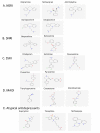Antidepressants are a rational complementary therapy for the treatment of Alzheimer's disease
- PMID: 20226030
- PMCID: PMC2845130
- DOI: 10.1186/1750-1326-5-10
Antidepressants are a rational complementary therapy for the treatment of Alzheimer's disease
Abstract
There is a high prevalence rate (30-50%) of Alzheimer's disease (AD) and depression comorbidity. Depression can be a risk factor for the development of AD or it can be developed secondary to the neurodegenerative process. There are numerous documented diagnosis and treatment challenges for the patients who suffer comorbidity between these two diseases. Meta analysis studies have provided evidence for the safety and efficacy of antidepressants in treatment of depression in AD patients. Preclinical and clinical studies show the positive role of chronic administration of selective serotonin reuptake inhibitor (SSRI) antidepressants in hindering the progression of the AD and improving patient performance. A number of clinical studies suggest a beneficial role of combinatorial therapies that pair antidepressants with FDA approved AD drugs. Preclinical studies also demonstrate a favorable effect of natural antidepressants for AD patients. Based on the preclinical studies there are a number of plausible antidepressants effects that may modulate the progression of AD. These effects include an increase in neurogenesis, improvement in learning and memory, elevation in the levels of neurotrophic factors and pCREB and a reduction of amyloid peptide burden. Based on this preclinical and clinical evidence, antidepressants represent a rational complimentary strategy for the treatment of AD patients with depression comorbidity.
Figures


References
-
- Thase ME, Nierenberg AA, Keller MB, Panagides J. Group RPS. Efficacy of mirtazapine for prevention of depressive relapse: a placebo-controlled double-blind trial of recently remitted high-risk patients. The Journal of clinical psychiatry. 2001;62(10):782–788. - PubMed
LinkOut - more resources
Full Text Sources
Other Literature Sources

